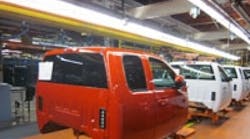Shortly after General Motor Co. (IW 500/4) emerged from bankruptcy reorganization in summer 2009, employees at GM's Fort Wayne (Ind.) Assembly Plant not only learned that the plant would be staying open, but also that they'd be getting more work -- and soon.
As part of its restructuring, GM had decided to shutter its truck and bus assembly plant in Pontiac, Mich., and move production of heavy-duty pickup trucks from Pontiac to Fort Wayne. In September 2009, GM announced that it was adding a third shift to GM-Fort Wayne, and in early 2010 the plant beefed up for the extra shift by bringing in 900 employees from 35 GM sites in 25 states.
While the consolidation certainly was welcome news for GM-Fort Wayne, there was one daunting challenge: The plant, which opened in 1986, never had built a heavy-duty pickup truck before.
That posed a problem in the paint shop, where the carrier system is too small to accommodate an extended-cab pickup truck with an 8-foot, or "long," box (essentially the bed of the pickup truck).
"It was going to cost us tens of millions of dollars in equipment and processes in the paint shop," says plant manager Mike Glinski. "So we had to come up with a creative process."
With the help of scheduling and engineering personnel at GM headquarters, the plant came up with the box-swap process.
How it Works
It works like this: The plant pairs two pickups that have been ordered with the same paint color -- a regular-cab pickup with a short box and an extended-cab pickup with a long box -- and swaps their boxes so they can be painted. After the two trucks go through the paint process, the boxes are returned to their original truck cabs.
GM indicates which pickups are to be swapped when it broadcasts orders to the plant, Glinski explains.
"There's nothing we have to do," Glinski says. "It builds through the body shop and the paint shop that way, and then it gets swapped after paint."
The plant faced a similar dilemma in assembly. To accommodate extended-cab trucks with dual rear wheels -- known as "dually" pickups -- in the assembly area, the plant would've had to make major modifications to its conveyance system there.
Instead, the plant devised another workaround.
When the plant receives an order for a dually, it builds the pickup without its box through the general-assembly process. Meanwhile, in the paint shop, the plant paints the dually's box in separate pieces -- the tub and the panels -- on two separate carriers.
After the dually-box components are painted, they are assembled and then placed on their cab and chassis in the paint shop.
"We were able to avert spending millions of dollars in our general assembly by doing that," Glinski says, "at a time when GM was a little tight on cash."
Just-in-Time Seat Replenishment
Today, more than 3,600 employees at GM-Fort Wayne produce light-duty and heavy-duty Chevy Silverado and GMC Sierra regular-cab and extended-cab pickups.
During a recent tour of the 2.85 million-square-foot facility, Glinski highlighted a number of other process innovations, including the plant's unique seat-replenishment process -- in which a local supplier delivers seats lineside on a just-in-time basis -- and an ergonomically designed hoist that removes the weight burden off operators who are installing 80-pound instrument panels.
GM-Fort Wayne performs all sequencing and subassembly in house, with the exception of its seat-replenishment system. When a truck is ready to leave the paint shop, the plant electronically transmits that information to its seat supplier, Advanced Assembly of nearby Columbia City, Ind.
"They then have 3.1 hours to build up these seats, in sequence, and get them delivered to lineside to be put into the truck," Glinski explains.
When the truck carrying the seats arrives at GM-Fort Wayne, automated technology takes over.
"They plug into our dock, and electronically that trailer interfaces with our conveyance system and brings that seat down to lineside, so the specific seat required for that vehicle goes into that vehicle at that time," Glinski says.
"The last person to see it [at the supplier's facility] is the inspector. The very next person to see it is the person who installs it."
Thanks to process innovations such as these, GM has recognized Fort Wayne Assembly as one of its most productive plants -- and rewarded it with more business. In October, the automaker announced that it will invest $275 million to prepare the plant to build the next generation of Chevrolet and GMC full-size pickups.
See Also:



